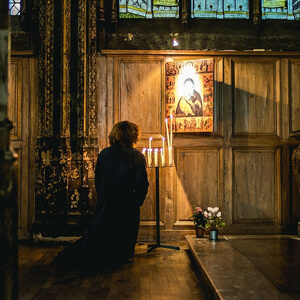
Here I quote from the commentary of the Ignatius Study Bible:
“6:7 empty phrases . . . many words: Jesus briefly considers the false religiosity of Gentiles. Pagans would recite long litanies of divine names to gain the attention of gods. This was meant to ensure that the deity was addressed properly. Jesus considers the practice empty—i.e., devoid of faith and of love for the deity. ”
Note that his warning is not aimed at repetitious or lengthy prayer in itself. With a pure heart, such prayer can be fruitful and intimate. Jesus himself prayed to the Father in Gethsemane three times “saying the same words” (Mt 26:44) and “all night” (Lk 6:12) before choosing the apostles (CCC 2668).
Here are my own comments:
First of all, some Protestants also pray repetitive prayers and at great length. For example, many evangelical gatherings would have long invocation prayers for impartation of spiritual gifts and healing, as well as long Praise and Worship sessions; as well, the Pentecostals and Evangelicals have immersion prayers that could last for several hours and even days.
The question directly addressed to Rosary, therefore, is not its repetitiveness or length, but that it was rather empty and mechanical, devoid of intimacy with God.
To which, I do admit that we Catholics have at times gave false witness to this beautiful and contemplative prayer. Too often and too many of us, especially when praying the Rosary in public, have done so hastily and without affection. The Rosary’s beauty is that in each decade, it focuses us to meditate and contemplate on the various mysteries of the Gospel. The seemingly repetitiveness of the “Hail Mary”s is supposed to help us focus on Jesus, as we imitate Mary’s pondering of the Word, or intimately calling on our heavenly Mother “I love you” or “Teach me to follow your Son”.
The second objection raised against the Rosary, of course, is why do we pray so many “Hail Mary”s? If we were to repeat any prayer, should we not repeat the Lord’s Prayer instead?
Interestingly, the Rosary was initially prayed as 150 “Our Father”s! It went through a few changes later on before becoming today’s format. There are many reasons that influenced the changes, and I would not say the current format is better or worse. But regarding the virtues of the current format, I would say the following:
– it imitates the early Church after Jesus’ Ascension and waiting for the Descent of the Holy Spirit, when the 120 disciples gathered around Mary to pray. Here, Mary was revealed as the Mother of the Church, teaching us how to pray and to be open to the Holy Spirit. Our repetitive “Hail Mary”s is therefore to participate in that same school of Mary, to pray with her and to learn from her, the perfect disciple. No one could dispute that this focus on Mary is not at the same time focus on Jesus, the Holy Spirit and the promise of the Father.
– Mary is also the reflection of the fullness of grace promised to us. What Mary was given by a singular grace (immaculate conception and Assumption) has also been given to us by the grace of living out our salvation, albeit with fear and trembling. Imitating her therefore is not drawing us away from Jesus, but in fact is drawing closer to Jesus by staying close to one who reveals the perfect way of reflecting Jesus’ face.
– and of course, there are the teachings of St. Louis Marie Grignion de Montfort, followed by those of St. Maximilian Kolbe, St. Teresa of Calcutta, and Pope St. John Paul II, who consistently taught the Church that Mary’s is the fastest, easiest and surest way to Jesus. I will not elaborate on this point here. You may read Fr. Michael Gaitley’s book “33 Days to Morning Glory”.


